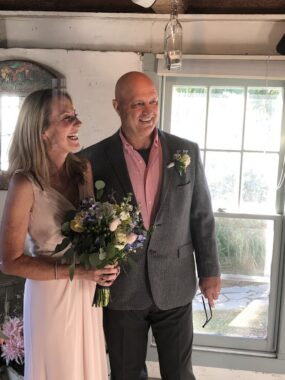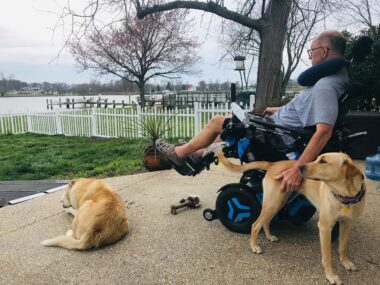The long search to find an accessible home while living with ALS
Leaving a beloved house to find a more accessible one was a difficult process

When my late husband, Jeff, was diagnosed with ALS, we were living in a small rented farmhouse that we both adored. Jeff loved the sprawling lawn that led to a tidal fishing pond and the flower beds that had been meticulously planted by the home’s owner. I appreciated the interior features — a quirky chimney that twisted up through the middle of the living room and an adjoining milk house where dairy from the farm’s cows had once been stored. The home and property were cozy and peaceful. It was a special place to live, and we felt fortunate.

Juliet Taylor and Jeff Sarnacki on their wedding day at home, 10 days after Jeff’s ALS diagnosis in 2018. (Courtesy of Juliet Taylor)
Ten days after Jeff’s ALS diagnosis, he and I got married in the milk house. Our neighbor, who had become a fast friend and confidant, officiated the short ceremony, and afterward we went to our favorite deli for a wedding breakfast. I wore a rented dress and carried flowers from the grocery store. It couldn’t have been more perfect.
So it was with sadness when we realized that we wouldn’t be able to stay in our beloved home. No one knows the timeline of their ALS, and in Jeff’s case, his progression was fast. Within 10 months of diagnosis, he needed a power wheelchair. At 425 pounds, the chair was too unwieldy to traverse the chimney in the living room or navigate the narrow hallways. Each entrance to the house had steps — not many, but just enough to make getting in and out impossible.
With regret, we realized we would need to move — yet another loss in the constant barrage of losses that ALS brings. Neither of us wanted to go, but we realized it was necessary for Jeff’s safety. This was not just an emotional loss but a financial one as well. ALS is staggeringly expensive, and renting had been a perfect solution for us, allowing us to save our nest egg for other needs.
An emotional search
We approached our home search with little enthusiasm. Our needs were specific and a constant, piercing reminder of what ALS was taking from Jeff: no steps, no thresholds, wide doorways. Our focus was, as it needed to be, on safety and physical well-being.
We enlisted the help of our dear friend Lindsay, who was a local real estate agent, with what we knew would be a challenging search for a new home. Together the three of us developed a game plan: Jeff and Lindsay would identify possible homes online, and Lindsay and I would go see them. If we felt like the home could work — that he could get in and out safely, that the home was truly accessible or had the potential to be — we would go back with Jeff so that he could see it in person.
The home search was more emotional than I expected. Because we were sad to be leaving a place that we loved, nothing felt right. Some homes carried their own sadness, as well — ramps that had been constructed hurriedly or haphazardly, unusual modifications that had been made to accommodate wheelchairs and hospital beds, a reality we knew all too well.
In one case, a home looked perfect online, and when we arrived, all of the solidly constructed ramps had been removed to make it appealing to a wider array of buyers.
Home is what you make it
Discouraged after four months of house-hunting, and after several falls in our original rented home, Jeff expanded our geographic search. In doing so, he found a little cottage on Maryland’s eastern shore, about 25 miles from our original place. At 70 years old, the one-level home had been remodeled a few times. Its wide kitchen and great room offered space to navigate Jeff’s wheelchair, and there wasn’t a single stair in sight. It was situated on a calm creek where Jeff could enjoy nature. It seemed perfect.

Jeff Sarnacki enjoys a day outdoors with Rudder, left, and Sailor at their new home in 2020. (Photo by Juliet Taylor)
Lindsay and I pre-screened the home before bringing Jeff, and she and I were both optimistic. When Jeff rolled in on a visit the next day, he was silent. He checked out all the rooms with ease, and while Lindsay and I were talking in the living room, we noticed he was already in the backyard, which he’d been able to reach without assistance. I was hopeful.
When he came back inside, he gave both of us a smile and a thumbs-up. About a month later, aided by nearly 40 friends who came to help us move, we settled into the place where I’m writing this column today.
While it wasn’t the home we thought we’d wanted, it turned out to be perfect — a place where we made memories, visited with loved ones, and most importantly, lived safely and peacefully with Jeff’s ALS. I learned in our search that, when living with ALS, flexibility and perspective are everything, and home is what you make it.
Note: ALS News Today is strictly a news and information website about the disease. It does not provide medical advice, diagnosis, or treatment. This content is not intended to be a substitute for professional medical advice, diagnosis, or treatment. Always seek the advice of your physician or other qualified health provider with any questions you may have regarding a medical condition. Never disregard professional medical advice or delay in seeking it because of something you have read on this website. The opinions expressed in this column are not those of ALS News Today or its parent company, Bionews, and are intended to spark discussion about issues pertaining to ALS.







Edward
Great story Juliet!
My story is somewhat similar. After 3 years of taking care of girlfriends parents and actually moving in the last 2 years. We realized how their house was not prepared to take care of senior citizens. Wide doorways, walk in showers, high toilet seats, everything on 1 floor. We were living in a 2 story house at the time that stood practically empty during our care giving time. After her parents borh passed of old age, Lisa and I decided to buy their house and do everything right for old age as we were both now retired. 2 years into the renovations of totally gutting the house I was diagnosed with ALS. Who knew I would need all these things so soon. But obviously someone above was steering us in this direction. After friends and family helped us move in, I proposed to Lisa , she accepted, her and her friends totally converted our garage to a wedding hall. We had 35 close friends and family and the day was perfect. Now as I declining, I am grateful for all the things we did in our house, never thinking the time was going to be now.